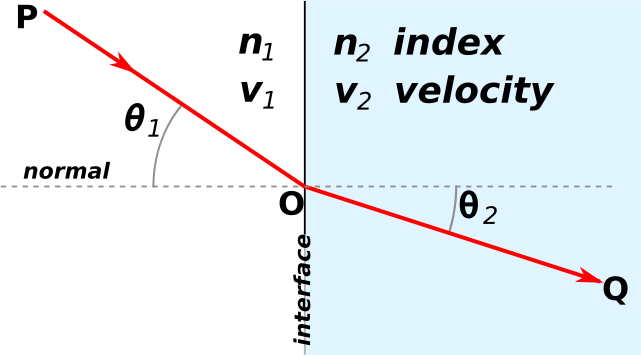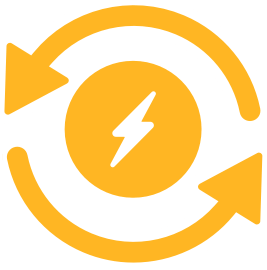| Topic: Quantum Mechanics Introduction | |
|---|---|
|
Edited by
Quietman_2009
on
Tue 08/25/09 06:45 AM
|
|
|
this one gets tricky
someone mentioned the double slit experiment if you shoot light through a double slit set up like below. you get constructive and destructive interference from the wave properties of light and the result is a series of light and dark bands 
but they found if they shoot a single photon at a time through the same set up you STILL get constructive and destructive interference. which would seem impossible if there is only one photon going through at a time but the potential photons are interfering with the single photon. and that is where Quantum stuff gives me a headache |
|
|
|
|
|
At least we have some pictures to look at this time to get a understanding
 
|
|
|
|
|
|
Edited by
Quietman_2009
on
Tue 08/25/09 07:05 AM
|
|
|
yeah the math kills me. I have to have conceptual pictures to visualize stuff haha
but I guess first you have to know the principles to know where to find the pictures light is weird stuff. there is a principle called birefringence in which a material bends light at two different speeds 
light has a phase to it and there are P rays and S rays based on the phase and some materials bend P rays and S rays differently. and P rays (or is it S rays? I forget) don't reflect. The glare off a windshield is light stripped of it's P rays and it hurts the eye. Polarized sunglasses block the P rays and reduce glare |
|
|
|
|
|
sorry for all that. I get carried away
|
|
|
|
|
|
No by all means continue! It is very interesting and alot of us appreciate your effort.

|
|
|
|
|
|
Edited by
Quietman_2009
on
Tue 08/25/09 07:07 AM
|
|
|
hahaha I'll have to come back later. I have a four hour drive to see a doctor and I got so carried away that I'm late
I'll come back this evening and check in just remember 186,000 miles per second. It's not just a good idea. It's the law |
|
|
|
|
|
Okay take care and I hope you get good results from the doctor.
I will remember 186,000 per second! Whew that is fast  
|
|
|
|
|
|
sorry for all that. I get carried away I heard someone mention a lie detector outside a building the other day. The US and soviets used to spy on each other by beaming a laser at a pane of glass and measuring the movement of the glass caused by the sound vibrations of people in the building talking ( a laser mic ). You worked on stuff more sensitive than that. Could they measure "stress" in the voice with the same technology? How good a microphone can you make with a laser? |
|
|
|
|
|
metalwing wrote:
No Abra, it is you that can write a million words to prove over and over that you don't understand how light really does slow down in a medium. And you keep trying to throw the word "particle" into the argument because you don't have a clue. You're giving the classical explanation hon. I was addressing the quantum explanation. The classical explanation can't hold without aether. But there is no aether. Perhaps you missed that part? Does Michelson and Morley ring a bell? 
|
|
|
|
|
|
If you believe that Quantum Mechanics isn't affected by the macro environment please explain to us why a double-slit experiment and a single-slit experiment have different quantum results? The only difference in those two experiments is the macro environment is it not?
Different quantum results? Aside from that unnecessary qualifier the results from both are quite easy to explain James. One has a single slit, which offers no chance for interference. The other has two which does. The quantum mechanical 'puzzle', as it were, is had when a double slit experiment is performed with a single photon at a time. Does sum over possibilities ring a bell, you know... Feynman? |
|
|
|
|
|
metalwing wrote:
No Abra, it is you that can write a million words to prove over and over that you don't understand how light really does slow down in a medium. And you keep trying to throw the word "particle" into the argument because you don't have a clue. You're giving the classical explanation hon. I was addressing the quantum explanation. The classical explanation can't hold without aether. But there is no aether. Perhaps you missed that part? Does Michelson and Morley ring a bell? 
I suggest anyone who thinks light cannot slow down in a medium just look it up. My explanation was the quantum explanation. If your explanation was true, in any form, fiber optics wouldn't work, waveguides wouldn't work, etc. Once again you are confusing quantum effects with particle behavior because you cannot grasp the concept that the wave functions explain what is happening. No matter how big a mistake you make, you have an endless supply of misdirections and "name dropping" to pretend you understand something that you missed completely. The Facts Light slows in a medium due to the wave properties. It isn't absorbed and re emitted like you say with the speed staying constant. Apparently you do not understand the simple concept of transparency. That whole concept of absorption and re emitting does not apply. You just continuously try to change the subject to hide the fact that your statements were false. You keep saying things that "sound good" to someone who doesn't understand the topic. Which is pretty much a summery of why I said this thread was a train wreck... |
|
|
|
|
|
Jeremy calls it 'moving the goal posts'. I call it deflection.
|
|
|
|
|
|
I would, however, like to thank you guys for bringing substance into the thread worth reading. I enjoyed the examples as well. The cases have been presented well.

|
|
|
|
|
|
Edited by
Quietman_2009
on
Tue 08/25/09 10:52 AM
|
|
|
Light slows in a medium due to the wave properties.
ummmmmm, I thought I just showed that it did the whole concept of a medium having an index of refraction is the ratio of the speed of light in a vaccum to the slowed speed of light in the medium speed of light in a vaccum = 186,000 mps speed of light in water = 140,000 mps 186,000/140,000 = 1.33 thus the index of refraction of water is 1.33 |
|
|
|
|
|
Edited by
Bushidobillyclub
on
Tue 08/25/09 10:59 AM
|
|
|
Light slows in a medium, it doesn't jump around.
that is why materials have an "index of refraction" the refractive index of air is 1 water is about 1.5 that is why light bends as it passes through glass or water Now that is interesting indeed. Thanks for sharing that as I always wondered why light turns directions in water or like you say bends. that's why fiber optics work. if the light bends enough there is "total internal reflection" and it stays in the material instead of passing through There is a band of ocean water that is warmer then the layer above and below and when the sound reaches the cooler water is refracts inward keeping the signal inside the channel. Light slows in a medium, it doesn't jump around.
that is why materials have an "index of refraction" the refractive index of air is 1 water is about 1.33 that is why light bends as it passes through glass or water 
I understand that light refracts... I even understand the math. What I've never really understood is why, when light slows, it changes direction. What causes it to actually bend? that comes from the wave property of light. when it meets a medium with a different index of refraction (think of it as thicker) the leading edge of the wave is slowed down while the trailing edge of the wave doesn't and that causes it to bend A change in speed on one side causes a change in direction relative to the change in speed. |
|
|
|
|
|
Edited by
Quietman_2009
on
Tue 08/25/09 10:57 AM
|
|
|
sorry for all that. I get carried away I heard someone mention a lie detector outside a building the other day. The US and soviets used to spy on each other by beaming a laser at a pane of glass and measuring the movement of the glass caused by the sound vibrations of people in the building talking ( a laser mic ). You worked on stuff more sensitive than that. Could they measure "stress" in the voice with the same technology? How good a microphone can you make with a laser? hmmmm maybe the idea of eavesdropping using a laser is a kind of a off shot of LIDAR. you shoot the beam and measure the time of flight of the reflection. They use that in digital terrain mapping a lot. so I'm assuming the vibrations on the window glass alter the reflection of the laser on a pico scale. I'm not sure how you would apply it to quantify stress in a voice |
|
|
|
|
|
metalwing wrote:
No Abra, it is you that can write a million words to prove over and over that you don't understand how light really does slow down in a medium. And you keep trying to throw the word "particle" into the argument because you don't have a clue. You're giving the classical explanation hon. I was addressing the quantum explanation. The classical explanation can't hold without aether. But there is no aether. Perhaps you missed that part? Does Michelson and Morley ring a bell? 
I suggest anyone who thinks light cannot slow down in a medium just look it up. My explanation was the quantum explanation. If your explanation was true, in any form, fiber optics wouldn't work, waveguides wouldn't work, etc. Once again you are confusing quantum effects with particle behavior because you cannot grasp the concept that the wave functions explain what is happening. No matter how big a mistake you make, you have an endless supply of misdirections and "name dropping" to pretend you understand something that you missed completely. The Facts Light slows in a medium due to the wave properties. It isn't absorbed and re emitted like you say with the speed staying constant. Apparently you do not understand the simple concept of transparency. That whole concept of absorption and re emitting does not apply. You just continuously try to change the subject to hide the fact that your statements were false. You keep saying things that "sound good" to someone who doesn't understand the topic. Which is pretty much a summery of why I said this thread was a train wreck... Nothing I said conflicts with the propagation of light light slowing down in a medium. On the contrary it explains precisely why it occurs whilst simultaneously perserve that no photon has ever traveled at less than the speed of light in a vacuum. Nothing I said conflicts with materials being transparent either. On the contrary it explain precisely why this is so. Besides, how could the classical picture explain it in terms of waves slowing down without an aether?' What would make the waves slow down? What are they traveling 'through'? Surely you're not suggesting that they are traveling 'through' the atoms. That makes no sense at all. The only way the classical view could possibly work is if we attribute a denser 'aether' to materials. The classical math only works out because we CHEAT! We just measure how fast light travels through a material and then assign that material a 'constant' that we use for the calculations. So the whole classical 'theory' is just a 'fudge factor' that can't be calculated. It can only be measured. Like I say, the explanation that you are using is the classical explanation, NOT the quantum explanation. Did you happen to noticed the title of this thread? This isn't classical physics 101. We're talking about the quantum picture here. I don't deny that you can use the classical picture to do engineering calculations for light. It works just fine because of the "fudge factor". We just measure how fast light moves through a material and use that as a constant. It doesn't matter whether the theory is right or not in that case. So that's why the classical math works out. But without an aether the classical explanation can't work. What would make the waves slow down? There isn't anything to travel through from the quantum view. Just atoms and the empty space around them. If you don't have light interacting with the atoms in some quantum way, then there would be no reason for the light to slow down at all. And if you have the light interacting with the atoms then Planck's Constant demands that it must be a quantum interaction. So where do you go from there? Looks to me like you're up the creek without a paddle or a boat. Either you come up with the aether, or you accept the quantum explanation, there's no where else to turn. Sorry, but all your screaming and ranting isn't getting you anywhere. |
|
|
|
|
|
Light slows in a medium, it doesn't jump around.
that is why materials have an "index of refraction" the refractive index of air is 1 water is about 1.5 that is why light bends as it passes through glass or water Now that is interesting indeed. Thanks for sharing that as I always wondered why light turns directions in water or like you say bends. that's why fiber optics work. if the light bends enough there is "total internal reflection" and it stays in the material instead of passing through There is a band of ocean water that is warmer then the layer above and below and when the sound reaches the cooler water is refracts inward keeping the signal inside the channel. yeah, same principle. The only difference between ELF, radio, light, microwaves and Xrays is the frequency and where they sit on the electromagnetic spectrum thats why an electron microscope works. atoms are smaller than the wavelength of light that we can see. So they use a wavelength that is of a comparable size (appx 50 pico) |
|
|
|
|
|
Light slows in a medium, it doesn't jump around.
that is why materials have an "index of refraction" the refractive index of air is 1 water is about 1.5 that is why light bends as it passes through glass or water Now that is interesting indeed. Thanks for sharing that as I always wondered why light turns directions in water or like you say bends. that's why fiber optics work. if the light bends enough there is "total internal reflection" and it stays in the material instead of passing through There is a band of ocean water that is warmer then the layer above and below and when the sound reaches the cooler water is refracts inward keeping the signal inside the channel. Light slows in a medium, it doesn't jump around.
that is why materials have an "index of refraction" the refractive index of air is 1 water is about 1.33 that is why light bends as it passes through glass or water 
I understand that light refracts... I even understand the math. What I've never really understood is why, when light slows, it changes direction. What causes it to actually bend? that comes from the wave property of light. when it meets a medium with a different index of refraction (think of it as thicker) the leading edge of the wave is slowed down while the trailing edge of the wave doesn't and that causes it to bend A change in speed on one side causes a change in direction relative to the change in speed. I think this is where I'm struggling to comprehend it. I understand why a car pulls to the side under similar circumstances.... running down the road and passing through a diagonal line of water on the ground, for instance. I guess I'm struggling with giving light the same 'properties' as a car. On the car, the first corner hitting the water slows... which pulls the car in a direction, but only because the whole car is physically one unit. But since in my mind light isn't a 'physical' thing (yeah, yeah, wave/particle properties of light, lol) then I struggle with why it changes direction. |
|
|
|
|
|
Edited by
Quietman_2009
on
Tue 08/25/09 11:21 AM
|
|
|
maybe this will help

at least its a cool graphic |
|
|
|
|











